June 7, 2022
A Simple Overview of Conversational Design
Bridging the gap between your organization and beneficiaries is no small feat. Chatbots are gradually becoming the most user-friendly and cost-effective method to approach this issue. It’s especially true during the pandemic era when some NGOs shifted from on-ground activities to reaching their beneficiaries through chatbots.
Even so, there is still a lot of untapped potential where NGOs just like you, big or small, can leverage the power of chatbots to reach your target beneficiaries effectively. Let’s talk about this further.
Why does your NGO need a Chatbot?
There are multiple use cases for how you can extend your NGO’s impactful initiatives to your target audience through the use of chatbots.

Chatbots can be used to
- Create awareness about your organization or product:
- Relay information to the beneficiaries.
- Take feedback:
- Q&A
- FAQs
- Understand user response to your program or content.
- Monitor engagement and reach.
- Collect data.
The possibilities are endless.
Process for Designing the Conversations
We have an exciting journey ahead. Let’s start!
Step 1: Think about the Chatbot’s Goal and Users’ Challenges:
You will first need to determine the end goal for the chatbot: what is it that you want to achieve through the chatbot. Reflect on the pain points of your target users– what are the problems they face that your NGO can solve through the chatbot. Document the goal and pain points.
For instance, the goal can be to regularly update the users about events that your NGO is conducting for the beneficiaries and create awareness about your programs.
Pain points of the users can be
- They are not receiving information that is specific to their interests.
- The information about your NGOs programs is not easily accessible.
Chalk out a plan that consists of the upcoming courses of action which we are going to discuss in detail further. It’ll be helpful to deliberate on their timelines as well.
Summary of the Action Steps:

Step 2: Examine your Current Bot if any:
Feel free to skip to Step 3 if you don’t have a pre-existing chatbot. But if you do have one, read on.
*NOTE: In both cases, we suggest that it will be helpful for you to look through the definitions of what, why, how, where and when mentioned below.*
If you wish to enhance your current chatbot’s user experience, you should begin by conducting an audit of the same. Go through the existing flows and messages. Some of the aspects that you need to check while conducting this audit are:

- Length of messages and flows: Are they short and to the point?
- Do the messages add value to the users?
- Are there any links broken between the flows?
- Do the messages sound engaging to the users?
- If there are any external links and media added, do they add value to the users?
- Are the external links working?
Following this process, generate reports and analyze the scope of improvement. You will need to document and define the 5 main questions: what, why, how, where and when.
“What”: What are the aspects that you want to refine in your chatbot? Is there anything you would like to add/remove?
For example,
- Content length
- Tone of messages
- Use of rich media and external links
- What kind of data is being collected
- If the content is relevant and personalized to the users’ challenges
“Why”: Why do you think the aforementioned aspects are an issue?
For example,
- If the messages are lengthy, users can get lost many times in a single conversation. You need to remind them where they are and what they are doing by constantly checking if they’re following the messages.
- If the messages are not personalized to the users’ needs and challenges, they are likely to ignore the messages along with the ones that might be relevant to them.
- If the flows are all content and no play, such as rich media, the users might not be engaged.
“How”: How are you planning to make these changes?
For example,
- People generally appreciate short, easy-to-grasp messages that quickly get to the point and answer their questions.
- Get your creative juices flowing. Make the content more engaging and informative. Girl Effect’s Indian chatbot, Bol Behen, is a great example of creating a quirky and friendly message tone. Similarly, you can take inspiration from Mukkamaar’s bot as well.
- Keep trying different images and media so that you find the one that sticks.
“Where”: You need to identify the moments in the existing flows (users’ chatbot journey) where the edits will be made.
“When”: Define your project’s timelines.
Summary of the Action Steps:
- Go through the existing flows and messages and check what can be improved.
- Document this process by generating reports and defining the What, Why, How, When and Where.
Step 3: Step into the User’s Shoes:
Take a deep dive into the user’s mind and try to think of what could be the intent of the user and the barriers faced by them.
User intent is what the user wants to get done or the outcome they’re seeking when they engage with a chatbot.
The most effective method to do this is to directly speak to the target audience. This will help you to get closer to the primary problem and understand it better. It will lead you to think of the most optimal solution to provide value to the users through the chatbot.
Here’s a template that you can use to identify Intents and Barriers:
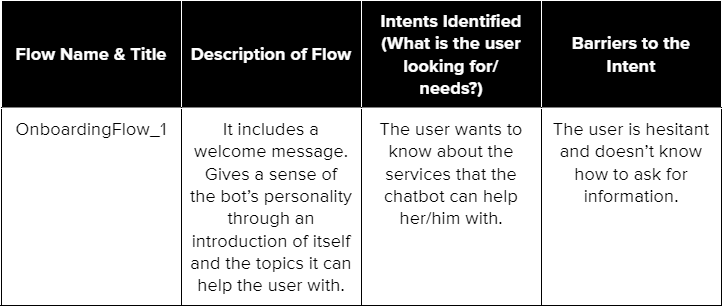
Summary of the Action Steps:
Define the intents of the users and the barriers faced by them.
Step 4: Map the User Journey:
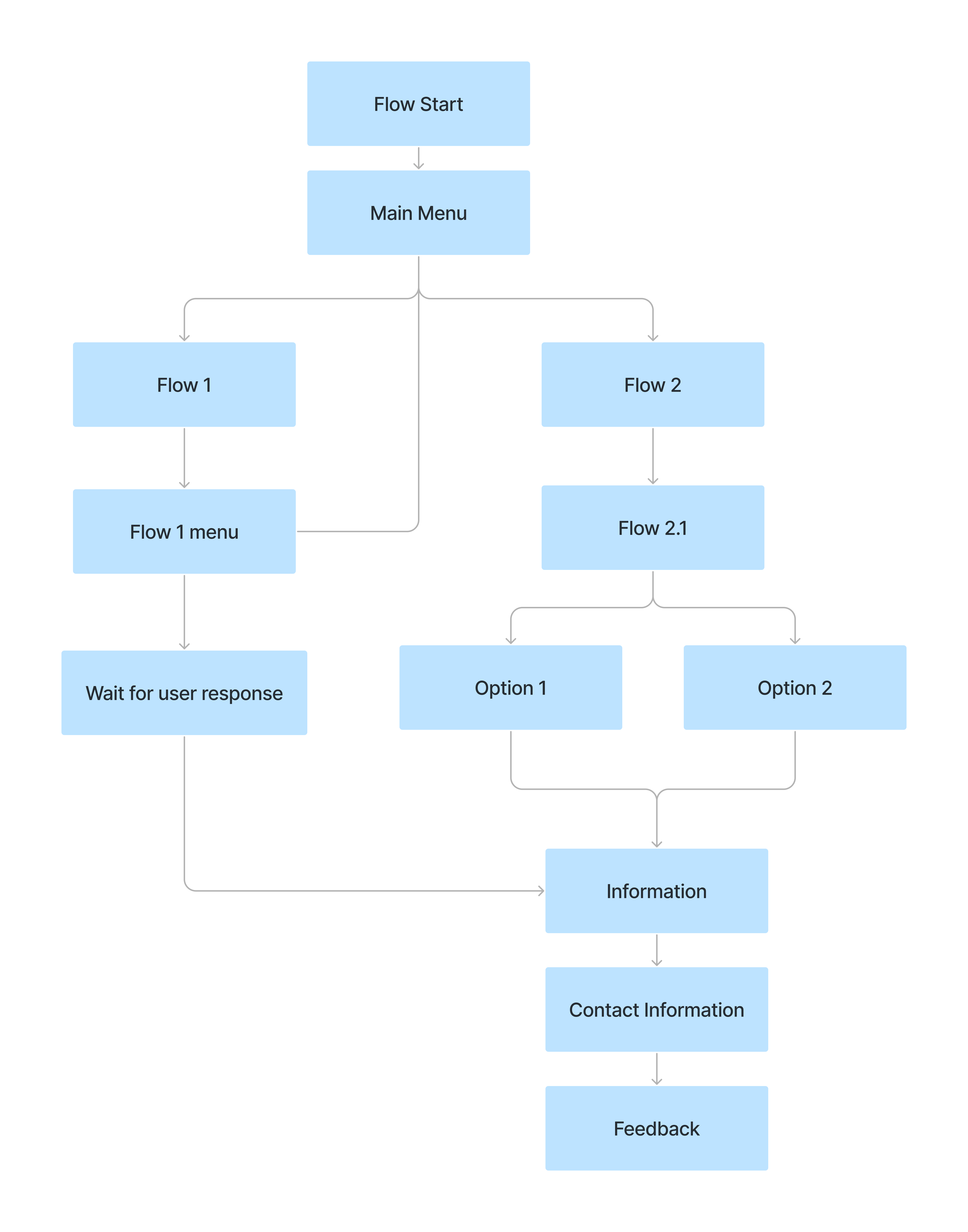
Think about the ideal conversation your chatbot needs to have with the users to solve their respective challenges. It can range anywhere from 2 to 20 messages, that’s up to you to decide and depends on user engagement.
Also, think about the actions they’ll take while accessing the chatbot. These actions could be quite minimal such as viewing the attached media, checking out external links attached, calling for support, etc… Mostly, they will be just responses to the messages. You need to keep them as easy and minimal as possible.
Create a rough draft of the user’s journey and iterate on what will work best.
Summary of the Action Steps:
- Ideate an ideal conversation that the chatbot will have with the users.
- Plan what actions the users will take while accessing the chatbot.
Time to Set Up the Chatbot!
Step 5: Bot Persona:
While setting up the chatbot, giving the bot a backstory and personality will help it find its voice and make it unique. Come up with aspects like motive, experience and age of the bot. A persona is a major factor in building an engaging chatbot.
If your existing chatbot already has a personality, you can go forward with creating the conversation flows in the same voice and tone or refining it to be more human-like and engrossing.
While talking about Bot Personas, two NGOs come to mind- Girl Effect and Mukkamaar. Their chatbots are excellent examples of constructing exciting Bot Personas. They resonate with their target audience and keep them engaged.
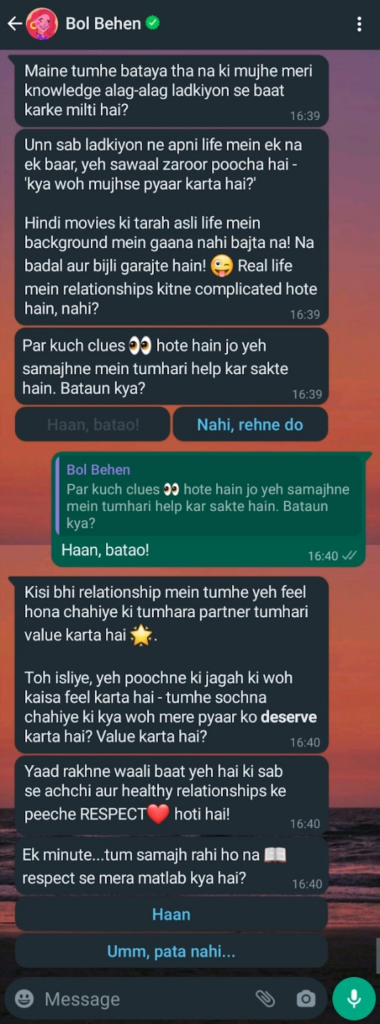
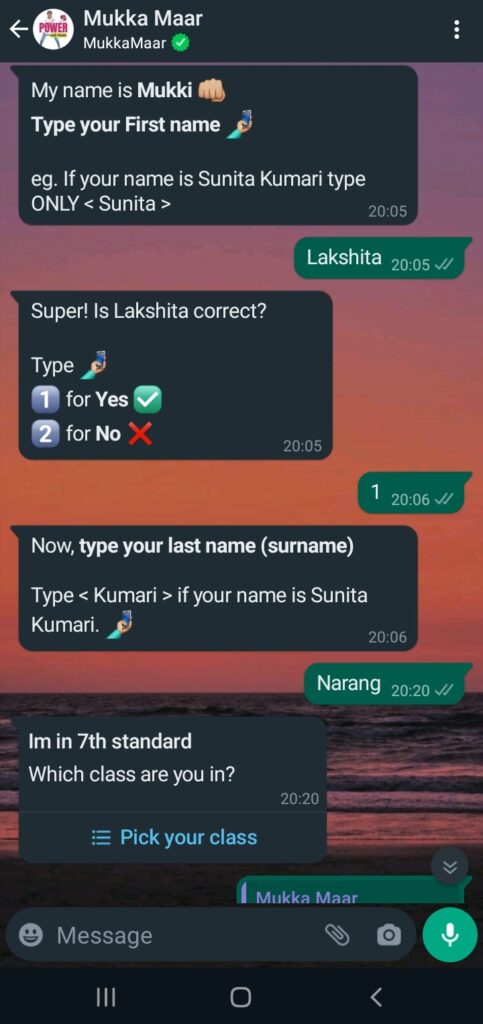
Summary of the Action Steps:
Give the bot a backstory, motive and personality by ideating on aspects such as a person with age and experience in life.
Step 6: Create Conversational Flows:
Let’s begin with creating a message concept. A message concept is fundamentally a summary and basic idea of each of the conversation flows that you’re going to write.
It can look something like this:

Go through the message concepts back and forth and decide what will work best to engage the users throughout their usage of the bot.
For the messages to sound effective and engaging, connecting to the user on an emotional level is the key. The messages should be preferably short and crisp and add value to the users. The messages can sometimes be detailed enough to build confidence in the user. For a good user experience, you can also:
- Sprinkle some emojis
- Add fun and valuable quizzes for the participants
- Give points for each task they complete
- Add pop culture or any references as per the audience
- Add GIFs or short videos
…the creative opportunities are limitless.
Summary of the Action Steps:
- Create conversation concepts of the messages.
- Write the final messages as short, crisp and those that add value to the users’ challenges.
Step 7: Decide the Development Platform of the Chatbot:
There are a ton of options available to develop the chatbot on. Many organizations use RapidPro but it may not be viable for all NGOs. Another prominent platform is Glific. It’s used by 40+ NGOs globally and in India and reaches lakhs of beneficiaries. The option of manual and automated engagement with the beneficiaries makes it highly convenient and cost-effective. This allows NGOs to scale their operations to wide geographies.
ColoredCow provides set-up support for Glific and RapidPro as well. Let’s talk more about it later.


You will also need to decide whether your chatbot needs to be based on WhatsApp, Telegram, Facebook Messenger, Signal, or any other social media platform.
Summary of the Action Steps:
- Decide whether you want to base your chatbot on WhatsApp, Telegram, Facebook Messenger, Signal, or any other social media platform.
- Think of which development platform you should use. Some of the options are Glific and RapidPro.
Step 8: Set up Flows:
Once the conversation flows have been reviewed and finalized and the development platform has been set up, you can start uploading the flows on the platform you have chosen or whichever platform supports your processes. You can make the messages interactive by creating buttons that the user clicks on and the flow takes its course according to the choices of the user.

Summary of the Action Steps:
Upload the conversation flows on the platform that you have chosen or whatever process the platform supports.
The Testing Phase
Step 9: Write Testing Script:
Testing Script is a line by line description of all the actions that are necessary to perform and test on specific user journeys.
It starts with a series of instructions for the internal testing team that can be as simple as “Test the flows on your mobile phone”. They are asked specific questions about their experiences while using the chatbot. In the end, they document their feedback about the same.

Summary of the Action Steps:
- Write a series of instructions for the internal testing team.
- Then ask them questions about their experience of using the chatbot.
Step 10: Define Success Parameters:
Success parameters are clear and concise metrics that will help you decide what the bot’s success will look like. For this, you need to formulate a series of report metrics and set up a dashboard. These parameters can be unique to your programs such as how many new users you are onboarding daily, how many users started vs. completed a quiz or learning flow, retention rate etc…
Summary of the Action Steps:
- Formulate a series of report metrics.
- Set up a dashboard.
Step 11: Internal Testing Phase:
There needs to be internal testing of all the flows before launching it to the users. The team can test the bot and mention their feedback according to the testing script. You can parallelly make the changes in case of any technical glitches or changes in content to be fully prepared for the next phase.
Summary of the Action Steps:
While the internal team is testing the bot, you can make the suggested changes parallelly.
Step 12: User Testing Phase:
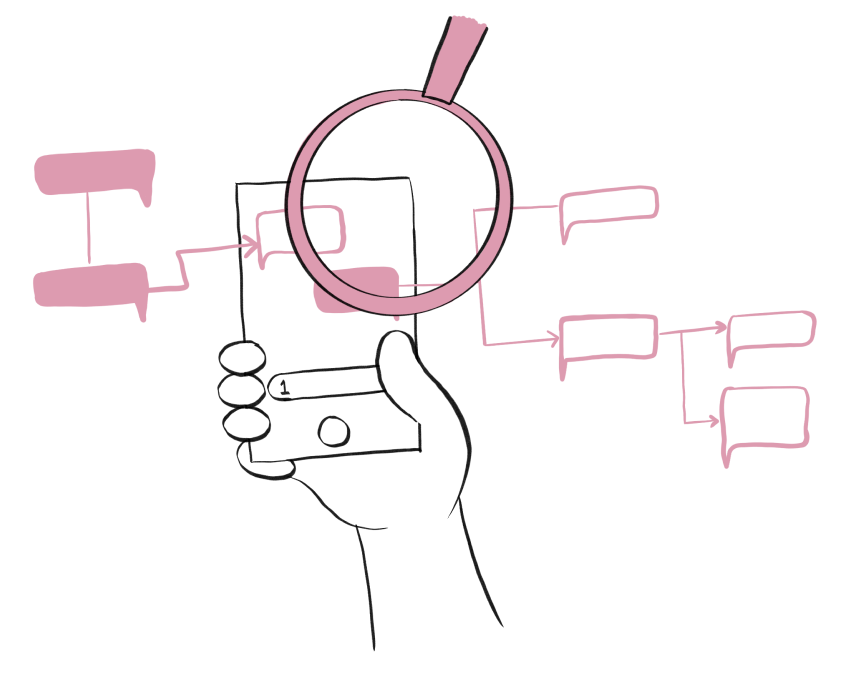
A sample of users is recruited from the target audience to conduct User Testing. Now you need to work on an outline of the process through which you will conduct User Testing. Write some questions that will help you build a rapport with the respondents.
The questions can be
- Introductions between you or the UX tester and the respondent.
- Respondent’s experience before interacting with the chatbot and the solution.
- Specific questions to understand the user’s intent of engaging with the chatbot.
- Why do the respondents take certain actions to reach their expected outcome?
- What do they feel about the chatbot?
Then it’s time to put together a series of UX Tasks that are scenarios that will help you gauge the experience of the respondents while they access the flows.
Summary of the Action Steps:
- Recruit a sample of the target audience.
- Work on a list of questions to ask them.
- Put together a series of UX Tasks to gauge the respondent’s experience while they access the flows.
- Conduct the aforementioned activities with the respondents and document your observations.
Step 13: Update the Flows:
Based on the findings from User Testing, you can review the flows and make changes to the messages.
The Last Stage
Get…Set…Ready to Launch!🚀
We’ve come a long way! Now you’ve done most of the hard work, it’s time to create some exciting marketing campaigns and launch your chatbot to the world. Soak in the feedback and keep iterating the bot by learning from the audience.
It might take a lot of iterations to get the message across just right. But as long as the user’s needs are in focus, the key to your success is if your efforts lead to any positive influence in the lives of the users.
Acknowledgement and credits:
Conversation Design Project: Girl Effect
Support with UX Testing: TEGA (Technology Enabled Girl Ambassadors) from Girl Effect
Illustrations: Hitesh Kumar Kohli
Assistance with RapidPro: Rudresh Shrotriya, Satendra Rawat, Gaurav Gusain and Mohd. Shamoon
Communication platforms: Glific and RapidPro